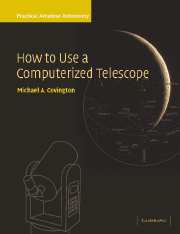Book contents
- Frontmatter
- Contents
- Preface
- Part I Telescopes in general
- 1 Welcome to amateur astronomy!
- 2 How the sky moves
- 3 How telescopes track the stars
- 4 Using equatorial mounts and wedges
- 5 Telescope optics
- 6 Eyepieces and optical accessories
- 7 Astrophotography
- 8 Troubleshooting
- Part II Three classic telescopes
- Index
6 - Eyepieces and optical accessories
Published online by Cambridge University Press: 10 February 2010
- Frontmatter
- Contents
- Preface
- Part I Telescopes in general
- 1 Welcome to amateur astronomy!
- 2 How the sky moves
- 3 How telescopes track the stars
- 4 Using equatorial mounts and wedges
- 5 Telescope optics
- 6 Eyepieces and optical accessories
- 7 Astrophotography
- 8 Troubleshooting
- Part II Three classic telescopes
- Index
Summary
What eyepieces do you need?
The ease and comfort of using a telescope depend to a surprising degree on the eyepiece, which contains more optical elements than the rest of the instrument. Most importantly, the eyepiece determines the magnifying power.
The magnifications that work well with any telescope are proportional to its aperture. For example, a 4-inch (10-cm) telescope at 25× and an 8-inch (20-cm) at 50× are both at the low end of their power ranges. They are operating at 2.5 power per centimeter of aperture, or 2.5×/cm for short, equivalent to about 6 power per inch.
What this implies is that the eyepiece focal lengths that work well with any telescope depend on its f-ratio. For example, a 20-mm eyepiece gives low power with an f/5 telescope but medium power with an f/10 telescope.
With that in mind, Table 6.1 makes specific recommendations. You do not have to get the exact focal lengths in the table, of course, but the table will show you where any particular eyepiece stands. If you have an f/10 telescope and choose to get a 32-mm eyepiece, which is not in the table, you'll know that it's in the low- to very-low-power range.
You do not need a lot of eyepieces. Three eyepieces are enough for almost anybody; two (low and high power) are almost enough; and one eyepiece (low or medium power) will get you started. Go for quality, not quantity.
- Type
- Chapter
- Information
- How to Use a Computerized TelescopePractical Amateur Astronomy Volume 1, pp. 79 - 98Publisher: Cambridge University PressPrint publication year: 2002

